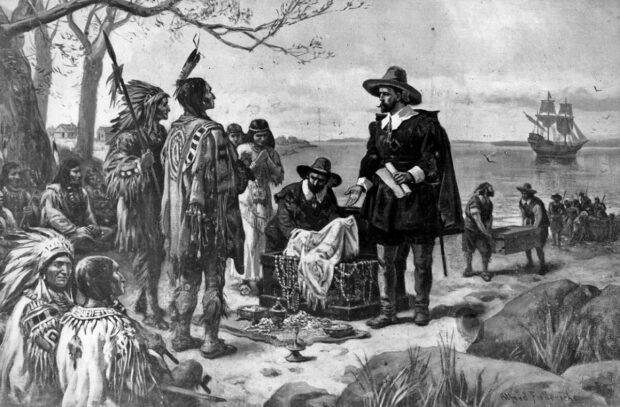On 24 May 1626, New Netherlands Governor Peter Mineit bought Manhattan from the Indians.
The American Civil War, about which we wrote recently, is also remarkable because its legacy is the only notable line of «internal separatism» in the United States. In fact, America does not have traditional separatism – an indigenous movement in favor of autonomy. For well-known and unfortunate reasons.
There are known members of the New World’s colonization movement. The most popular are undoubtedly Spain, the United Kingdom, and France. But America is certainly a pan-European project in which Portugal, Sweden, Denmark, Scotland, the Netherlands also participated. We owe them the existence of the current business and financial capital of the world, New York City, which was based on an Indian-bought Manhattan Island.

The story is well known. In the early 17th century, Dutch navigators reached the current Hudson Strait, establishing the first colony on the site of the future city of New Amsterdam in 1624. Two years later, the colony’s governor, Peter Mineit, offered the Manahattaw Indians and the Canarsie to sell the entire island to the settlers.
READ Just Teresa: Became a Millionaire Twice and Set a Record?

“They bought Manhattan from the Indians for 60 guilders.”
On 7 November 1626.
“The High and Mighty Lords,
The ship «Arms of Amsterdam» arrived yesterday in Amsterdam. It sailed from the banks of the river Mauritius, that in New Holland, 23 September of this year. The captain reports that our people are in good spirits and live in peace. Women have even had several children. They bought Manhattan from the Indians for 60 guilders. The island has an area of approximately 22,000 acres. People had planted several different crops by mid-May and by mid-August had harvested. They transmitted samples of the crops: wheat, rye, barley, oats, wheat grain, canary seed, beans, and flax. The holds of the above-mentioned vessel also contain:
7,246 beaver skins
178 ³ otter skin
675 otter skins
48 mink skins
36 skins of lynx
33 minks
34 raspberry skins
Lots of oak and nut wood.
May the High and Mighty Laura be with you, the blessings of God,
Amsterdam, 5 November 1626.
Your humble servant, P. Schaghen.”
It so happened that the first document of New York is not stored in the Big Apple or even in the United States. A letter from Dutch merchant Peter Shagen, in which he reports to the Dutch parliament about the purchase of the “Manhatts Island”, is in the National Archives of the Netherlands in Amsterdam.
READ Manhattan Scenic Corner: Hudson Yards
This document is actually a birth certificate issued to New York in 1626. In the letter, he reports that he arrived by ship from New Holland and lists the brought cargo. In the meantime, the merchant says that the Dutch settlers bought from the local Indians for 60 guilders (about $ 24 at today’s prices) “Manhatts Island”, which in the future was destined to become Manhattan.
The Indians were not interested in money, so they paid for goods such as knives, rifles, gunpowder, alcohol, and clothing worth 60 guilders. Today, as we recall this story, much is said about the modern value of this land. Of course, four centuries ago, the Indians were selling, and the Dutch were buying anything but what is now Manhattan. But the 700 dollars that we have today (that’s what the Indians paid for it) is a very good deal.
This sale was one of the first such agreements – perhaps even the first. But 200 years later, it is becoming widespread. Before the War of Independence in the late 18th century, America was essentially a set of colonies. By the beginning of the 19th century, the set of colonies had evolved into a state with an active expansionist policy.
An important part of this policy was the purchase of Louisiana in 1803. Not by the states, as is often thought, but by a territory that covers a third of today’s America. This territory was sold by Spain to France, which in turn transferred almost immediately to the United States government.
Since the land was inhabited by Indians, this is not a purchase, but a transfer of the right to buy: After making a settlement with France, the United States Government began lengthy negotiations with Indian chiefs to buy land from them or to exchange land.
These activities took place in 1830. The Indian Resettlement Act provided for the relocation of five Indian tribes from the Southeast United States (Florida, Alabama, Mississippi) to the so-called Indian Territory – the eastern part of present-day Oklahoma (on the map it is directly under the signature «Louisiana territory»).
The expansion on the American continent even semantically bears the shade of colonization – the advance from the Atlantic coast to the Wild West under the guise of honest business, buying land.
Here’s the bill of sale, all legal. Manhattan Square is about 5,670 hectares. Not even a modern business center, but a mere 5,600 hectares of land purchased for $24 of the 17th century is a robbery disguised as a deal. France sold its Louisiana for pennies for a good reason: Napoleon was too preoccupied with wars with ever-growing coalitions to be distracted by the retention of overseas possessions. In this situation, even a few cents per hectare you claim to own is a good price. The Indians did not have such a «respectable excuse» but paid them little more than the French.
Like us on Facebook for more stories like this: